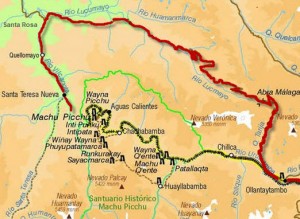 Peru’s Congress voted unanimously Thursday in support of building a new access road to Machu Picchu.
Peru’s Congress voted unanimously Thursday in support of building a new access road to Machu Picchu.
In a 75-0 vote, lawmakers declared that paving the narrow dirt roads connecting the towns of Ollantaytambo, Santa María and Santa Teresa, located northwest of Machu Picchu, is “a public necessity and a priority of national interest.”
In January, train service to Machu Picchu was cut off after the Vilcanota River overran its banks, wiping out the rail line and stranding thousands of tourists for days until they were airlifted out by helicopter. The Inca Citadel, Peru’s biggest tourist attraction, was closed for two months.
Machu Picchu “is an economic resource and a symbol for the nation, and for that reason it is the duty of the state and the Congress to hand down the laws that allow us to guarantee its conservation and adequate accessibility,” said José Carrasco, chairman of the Congressional Budget Committee.
Since the disaster in January, pressure has been mounting from Peru’s tourism sector to develop other routes in and out of Machu Picchu, not only to provide emergency exits from the zone, but also to break the near-monopoly held by PeruRail and the town of Aguas Calientes, located in the gorge below the ruins.
According to reports provided by the National Chamber of Tourism, each day Machu Picchu was closed caused losses in excess of one million dollars.

Congressman Jorge Foinquinos, chairman of the Foreign Trade Commission, said proposed legislation to build the alternative road access is needed “to provide for every contingency that may occur in the area and not depend exclusively on a rail line.”
The move by Congress puts it on a collision course with Peru’s National Institute of Culture (INC), which has made it clear that it — as the gatekeeper to Machu Picchu — is opposed to creating a new access route that could let the tourism floodgates fly wide open.
Peru’s government has worked hard to appease UNESCO’s demands to lessen the impact of visitors to Machu Picchu. The Andean nation narrowly escaped being added to the list of endangered World Heritage sites following the record surge of visitors in 2008, when the number of tourists far outpaced carrying capacity for the site on several days.
The UNESCO-sponsored Management Plan for Machu Picchu called for no more than 917 visitors per day – and no more than 385 visitors at any one time – while the INC has recommended a maximum carrying capacity of 2,000 visitors. Peru’s central government advocated in 2002 for 3,400, and the parties settled in 2008 on a daily limit of 2,500 visitors.
The deal was struck after the Peruvian government proposed a $132.5 million emergency plan to preserve the ruins and limit the flow of tourists, as well as take measure to prevent forest fires and landslides.
Carlos Canales, president of Peru’s National Chamber of Tourism (Canatur), has called into question the technical basis that the INC used for setting that limit at 2,500 visitors per day and advocates doubling the figure.
The INC’s study “was not prepared by specialists,” Canales contended in Monday’s edition of Peru’s main business daily Gestión. “Nor have international methodologies been used to measure the environmental impact and the burden caused by the number of visitors.”
“You can distribute the number of tourist routes into the sanctuary and you could easily double the amount estimated by the INC and reach up to 5,000 visitors a day,” Canales said in a statement on Canatur’s Web site.






Providing an alternative route is a great idea. The railway is precarious and vulnerable (I travelled it with my wife less than two weeks ago), and it’s only a matter of time until it’s wiped out by more landslides and flooding.
Peru needs the tourism revenue, and I wish them all the best in providing better infrastructure to support access to, and preservation of, this wonderful archaeological site.